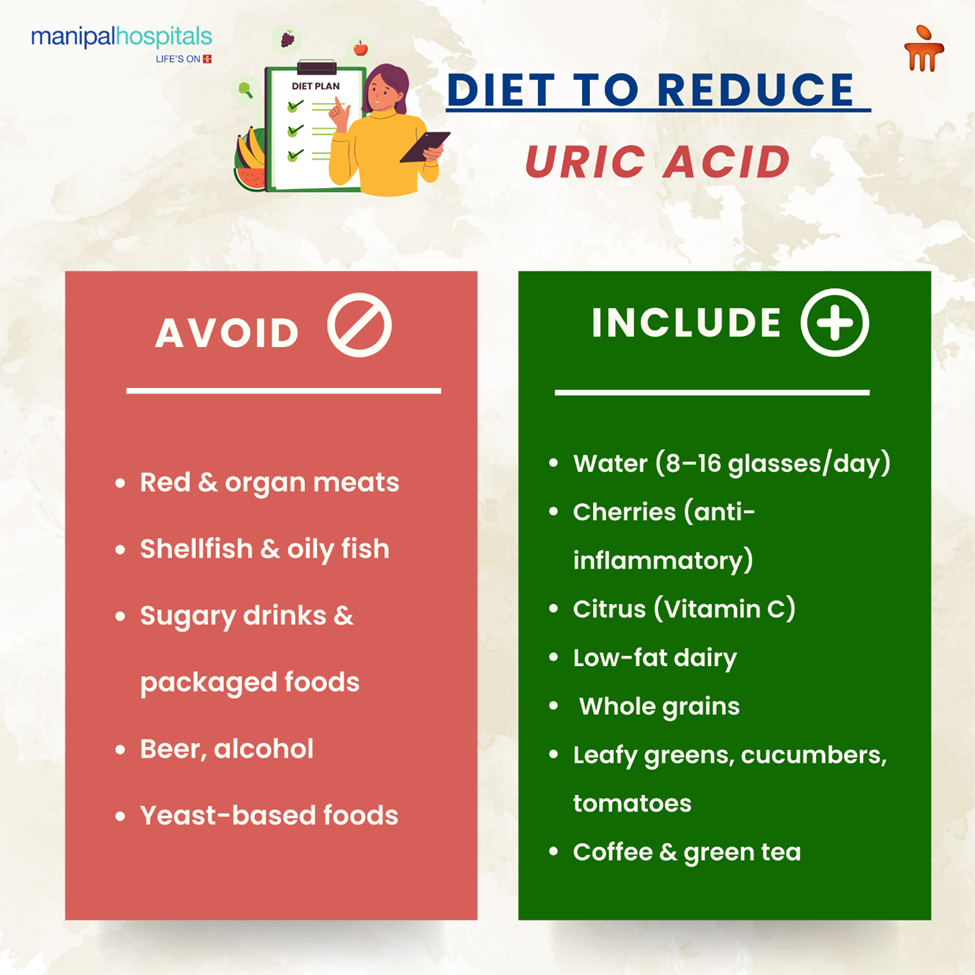
Uric acid is formed as a natural by-product of your body from the breakdown of purines and other compounds that are found in many food categories. The kidneys have the task of effectively removing uric acid. But sometimes high levels of uric acid can cause a condition known as hyperuricemia. This, in the long run, results in the formation of painful kidney stones or even joint inflammation (gout). If you have been suffering from inexplicable fatigue, stiffness or distressing joint pain, then it’s time that you recognise and understand the symptoms of uric acid. It’s also important to learn how to decrease uric acid in the body by making everyday changes.
The good news is that currently, we have a clearer understanding than ever of how to reduce uric acid in the body. In this blog, an experienced urologist and renal transplant surgeon in Sarjapur Road, Bengaluru, explains how to achieve that by making smart dietary choices, maintaining consistent daily habits, and undergoing proven treatments when necessary.
Synopsis
What Is High Uric Acid?
Typically, uric acid is dissolved in the blood and excreted through the urine. However, if your body produces too much or cannot eliminate it properly, it can accumulate. This accumulation can lead to problems such as joint pain, swelling (as seen in gout), or even kidney stones. Monitoring your diet, staying hydrated, and seeing a doctor if symptoms appear can help manage high uric acid levels.
Excess Uric Acid Symptoms
People do not often realise that they have elevated levels of uric acid in their bodies. This is because it doesn’t show obvious symptoms. But they do discover that they have hyperuricemia when it escalates into more severe concerns. The most common is a gout attack. Uric acid symptoms of a gout flare-up typically include:
-
Intense Joint Pain: This can strike suddenly and commonly in the big toe. However, it can also affect ankles, knees, wrists, and fingers. The joint pain can be sharp and debilitating and frequently occurs at night.
-
Swelling, Redness, and Warmth: The affected joint becomes inflamed, red, and hot to the touch. Even a light touch, like a bedsheet, can create extreme pain.
-
Stiffness: Joints may feel stiff, particularly in the morning or after periods of inactivity. They also make movement difficult.
-
Fatigue and Low Energy: Chronic inflammation can drain your energy. Hence, it leads to persistent tiredness and even mental fogginess.
-
Changes in Urine: Cloudy, dark, or strong-smelling urine is one of the signs. Discomfort while urinating or sharp lower back pain can indicate kidney stones formed from uric acid crystals.
-
Tophi: In long-standing, untreated cases, small, painless lumps called tophi can form under the skin around joints. While usually not painful, they can become inflamed and impair joint movement.
If you recognise any of these symptoms, it's crucial to consult a healthcare professional for diagnosis and to discuss a proper uric acid treatment plan.
How to Reduce Uric Acid Levels?
What you eat plays a pivotal role in managing uric acid. A smart diet focuses on limiting purine-rich foods and incorporating those that actively help your body excrete uric acid.
Foods to Limit or Avoid
-
High-Purine Meats: Organ meats like liver, kidneys, and sweetbreads; red meat like beef, lamb, and pork.
-
Certain Seafood: Shellfish like shrimp, lobster, scallops, and mussels. Specific fish types such as sardines, anchovies, mackerel, herring, trout, and tuna.
-
Sugary Drinks and Foods with High-Fructose Corn Syrup: Fructose breaks down into purines, which then increases uric acid. This food category also includes sodas, fruit juices with added sugar, and many processed foods.
-
Alcohol: Alcohol, particularly beer, is high in purines and also impairs your kidneys' ability to excrete uric acid. Even other alcoholic beverages can increase uric acid production.
-
Yeast and Yeast Extracts: Found in some gravies and spreads.

Foods to Embrace
-
Drink Plenty of Water: This is the most effective habit to remove uric acid. Drinking 8-16 glasses of water daily helps your kidneys flush out excess uric acid.
-
Cherries: Especially tart cherries are rich in anthocyanins. Also, cherries have potent anti-inflammatory properties and can help lower uric acid levels and reduce gout attacks.
-
Citrus Fruits: Oranges, lemons, and limes are excellent sources of Vitamin C, which aids in uric acid excretion.
-
Low-Fat Dairy Products: Milk, yoghurt, and cheese can help lower uric acid levels and may protect against gout.
-
Whole Grains: Oats, quinoa, brown rice, and other whole grains are high in fibre, which helps absorb and eliminate uric acid.
-
Fiber-Rich Fruits and Vegetables: Most fruits and vegetables are low in purines and packed with beneficial nutrients. Examples include apples (malic acid helps neutralize uric acid), bananas, leafy greens such as spinach and kale, cucumbers, zucchini, and tomatoes.
-
Coffee: Studies suggest moderate coffee consumption can help reduce uric acid levels.
-
Green Tea: Contains catechins, antioxidants that may help control enzymes related to uric acid production.
Daily Habits To Reduce Uric Acid
If you are wondering how to reduce uric acid levels, making a few changes to your diet and daily routine can go a long way in supporting your efforts.
-
Maintain a Healthy Weight: Excess body fat can contribute to higher uric acid levels and reduce kidney functioning. Steady, sustainable weight loss can significantly lower your uric acid level.
-
Regular Exercise: Engage in low-impact activities like walking, swimming, or cycling. These activities support weight management, improve circulation, and reduce inflammation.
-
Manage Blood Sugar Levels: High uric acid is linked to elevated blood sugar and an increased risk of diabetes. Keeping your blood sugar in check is vital.
-
Stress Management: Chronic stress can impact overall health and inflammation. Integrate stress-reducing activities like meditation, yoga, or spending time in nature.
-
Check Your Medications: Some medications, like diuretics and certain immunosuppressants, can raise uric acid levels. Discuss your medications with your doctor to see if any adjustments are needed.
What Really Works in 2025: Medical Treatments Available
While diet and lifestyle changes are the best ways to decrease uric acid naturally, sometimes medical intervention is necessary. It’s best for people with severe or recurrent gout attacks. Uric acid treatment in 2025 includes the following:
-
Medications for Acute Flares: For gout attacks, non-steroidal anti-inflammatory drugs (NSAIDs) and prescription medications are used. They can quickly reduce pain and inflammation. For personalised evaluation and treatment, consult our specialist in uric acid and gout management.
-
Urate-Lowering Therapy (ULT): For long-term management and prevention of future flares, doctors may prescribe certain medications. These work by reducing the body's production of uric acid or increasing its excretion. The goal is to consistently maintain serum urate levels below a target range (often <360 umol/L).
-
Supplements: While not a standalone solution, some supplements may offer additional support. Vitamin C can aid in the reduction of uric acid levels. Omega-3 fatty acids can help with inflammation, and folic acid may also play a role. Always consult your doctor before starting any supplements.
Conclusion
There is no permanent "cure" for high uric acid, but it is highly manageable. By combining a smart, low-purine diet with healthy daily habits, it’s possible for you to effectively reduce uric acid in your body. In cases of chronic conditions like gout, appropriate medical uric acid treatment can be effective. Take proactive steps today to reclaim your comfort and well-being.
Struggling with joint pain, fatigue, or recurring gout symptoms? Don’t ignore what your body is trying to tell you. At the urology department in Manipal Hospitals Sarjapur Road, our multidisciplinary expert team, including urologists, rheumatologists, and physicians, provides personalised uric acid treatment backed by the latest diagnostic tools and 2025 clinical practices.
FAQ's
You might notice symptoms of high uric acid, like joint pain. The pain particularly shows up in the toes or ankles, along with other symptoms like fatigue and cloudy urine. These signs suggest high uric acid, but only a blood test can confirm it.
A diet consisting of foods with low purine and good hydration can lower levels in many people. But if symptoms are severe or frequent, medication may also be needed.
Some supplements, like Vitamin C and Omega-3s, may help by tackling uric acid and inflammation. However, it’s best to check with your doctor before starting anything new, especially if you're on treatment.
Relief from symptoms can begin within weeks for some. Medications take longer to stabilize levels, so regular check-ups are important.
Yes, untreated uric acid buildup can lead to joint damage, kidney stones, or tophi. Managing it early helps avoid long-term problems.





















 9 Min Read
9 Min Read
















